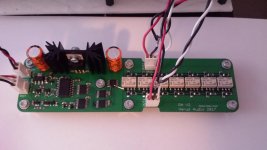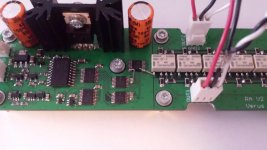Hi,
Can I use the Omron G6K-2G instead of a G6K-2F ?
You could use it, but as AndrewT said, you do not have easy access to the relay pins when soldering.
It could be done, yes, but I would personally prefer the G6K-2F version instead.
It is almost 3 years since I released V1 of this attenuator and 2 years since I mentioned making a V2 of it.
V2 will be ready in 3-4 weeks, I am done doing the layout, just need to make the Gerbers, order PCB's, components, assemble a board and do some testing.
The design is very close to the original but with some necessary changes/improvements.
Some info :
127 x 0.6 dB steps for an attenuation range of 0 to -76dB
10K impedance.
Onboard regulators, 5VDC for the digital logic and 5VDC for the relays.
A size of 150mm x 40mm.
Made a few improvements to the digital logic and a few bug fixes.
When I have more to show a new thread will be opened.
V2 will be ready in 3-4 weeks, I am done doing the layout, just need to make the Gerbers, order PCB's, components, assemble a board and do some testing.
The design is very close to the original but with some necessary changes/improvements.
Some info :
127 x 0.6 dB steps for an attenuation range of 0 to -76dB
10K impedance.
Onboard regulators, 5VDC for the digital logic and 5VDC for the relays.
A size of 150mm x 40mm.
Made a few improvements to the digital logic and a few bug fixes.
When I have more to show a new thread will be opened.
I still don't fully understand why a single potentiometer couldn't control two (or more) boards. Referring to the schematic attached to post #1, the control potentiometer (say 10k) is connected across the attachment points X3-3 and X3-1, with the wiper connected at X3-2. Point X3-2 goes into VIN+ of IC1.
Why can't a second attenuator board have a 10k resistor from X3-3 to X3-1, and have X3-2 connected to X3-2 of the first board (wiper of the only pot)? If interaction of the VIN+ pins of two boards would be a problem, could a DC coupled unity gain buffer isolate the pins?
Why can't a second attenuator board have a 10k resistor from X3-3 to X3-1, and have X3-2 connected to X3-2 of the first board (wiper of the only pot)? If interaction of the VIN+ pins of two boards would be a problem, could a DC coupled unity gain buffer isolate the pins?
I still don't fully understand why a single potentiometer couldn't control two (or more) boards. Referring to the schematic attached to post #1, the control potentiometer (say 10k) is connected across the attachment points X3-3 and X3-1, with the wiper connected at X3-2. Point X3-2 goes into VIN+ of IC1.
Why can't a second attenuator board have a 10k resistor from X3-3 to X3-1, and have X3-2 connected to X3-2 of the first board (wiper of the only pot)? If interaction of the VIN+ pins of two boards would be a problem, could a DC coupled unity gain buffer isolate the pins?
The way this board works, that is sadly not an option.
It could be done but require adding a 9 pin connector to the board and then have a smaller addon board that connects to the master board.
However, since I am limited to a size of 150 mm x 40 mm I really dont have the extra space for it, though I guess I could look into it some more. I had a colleague at work who asked me to make it possible to use it for balanced signals so you are not the only one that wants that option.
I also would like to see a balanced version.
/S.
/S.
The way this board works, that is sadly not an option.
It could be done but require adding a 9 pin connector to the board and then have a smaller addon board that connects to the master board.
However, since I am limited to a size of 150 mm x 40 mm I really dont have the extra space for it, though I guess I could look into it some more. I had a colleague at work who asked me to make it possible to use it for balanced signals so you are not the only one that wants that option.
The way this board works, that is sadly not an option.
It could be done but require adding a 9 pin connector to the board and then have a smaller addon board that connects to the master board.
However, since I am limited to a size of 150 mm x 40 mm I really dont have the extra space for it, though I guess I could look into it some more. I had a colleague at work who asked me to make it possible to use it for balanced signals so you are not the only one that wants that option.
It is not going to happen, V2 will be singleended only.
I just do not see the value in it. Balanced signals is great between equipment but internally I believe that singleended is the way to go.
I agree.It is not going to happen, V2 will be singleended only.
I just do not see the value in it. Balanced signals is great between equipment but internally I believe that singleended is the way to go.
Balanced impedance connections are for the connections
It's the connection that needs the balanced impedances, that reject the interference.
Any progress?
Yes, the PCB's have arrived in my country yesterday, now I am waiting for them to arrive at my adress.
So there is some progress being made, albeit slowly and totally out of my hands.
Yes, the PCB's have arrived in my country yesterday, now I am waiting for them to arrive at my adress.
So there is some progress being made, albeit slowly and totally out of my hands.
PCB's were delivered yesterday, components will be ordered tomorrow.
I should have something to show sometime next week.
PCB's were delivered yesterday, components will be ordered tomorrow.
I should have something to show sometime next week.
It took some time but it is finally done!
It had just 1 problem first time I turned it on, it didn't bloody work.
However the ULN2003 relay driver was getting pretty hot and there was 5 Volt at all outputs with the volume turned all the way down or all the way up. Turned out I made a schematic error, the ULN2003 Relay Driver should have PIN 8 GND connected to GND and PIN 9 COMMON connected 5V used for the relays. I had them switched on the schematic and therefore also on the board.
Luckily I just had to lift the PIN 8 GND and PIN 9 Common legs and sold them to the right connections, by using 2 clipped off and correctly bent legs from a LED and it worked.
Anyway now that it works I can safely say everything I wanted to achieve with V2 has been achieved. V1 could be a little unstable at times, relays going into constant chatter mode requiring you to turn the pot a little.
The changes I made in V2 removes this error mode, if it does happen and the POT voltage is just between 2 steps the relays stop changing state after between 1 or 2 relay cycles, that is 10 ms and 20 ms respectively and then it will stay 100% stable until you touch the volume control again.
All in all, I am very happy.
Last edited:
Did you consider right - left balance?
As it is now, with 0.1% resistors in the attenuator, channels should be better matched than 0.1dB at ALL volume levels.
EDIT : Just calculated it, the channels should be better matched than 0.02dB which should be plenty.
Last edited:
- Status
- This old topic is closed. If you want to reopen this topic, contact a moderator using the "Report Post" button.
- Home
- Source & Line
- Analog Line Level
- Pop/click free HW-based relay attenuator


